TOP > n.s.研究所 > 研究テーマ > 多細胞生物の行動に関する研究

公開日:2008年10月 1日
多細胞生物の行動に関する研究
複合刺激に対するボルボックスの応答
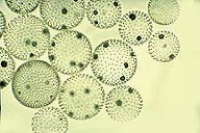
ボルボックス
(小さな球は子どものボルボックス)
ボルボックスは単細胞から多細胞へと進化を遂げた起源的な生物です。ボルボックスはゆらりゆーらり動いていますが、光をあてると光の方向に走り出します。
本研究では、環境中に複数の刺激がある場合に、感覚器官からの情報の統合をどのように行っているのか、ボルボックスがどのように判断しているのかを明らかにしていきます。
■連携機関 東北大学教養学部情報科学科菅原研究室
Effects of electrictaxis and phototaxis in Volvox carteri
Introduction
The behavior of microorganism has been described under the influence of a single kind of stimulation.
But, normally in nature the conditions are as a rule more complex than this; the animal is affected by
several sets of stimuli at once. "What is the behavior under such conditions?" if the animal is exposed
to two types of stimuli a and b at the same time, "Which types of stimuli deose the animal select to
resonce?". Or will it, react in a new way, different from the usual reactions to either a or b.
We would like to consider this responces of livning creatures from evolutionally primitive organisms.
Volvox is a primitive multicellular organism evolved from single-cell organism, cryptomonas. The cells
of Volvox carteri algal swim toward a light source or away from it. The direction of algal phototaxis is
revesed by enbironmental factors. Halldal([8], [9]) found that the sighn of phototaxis in Platymonas could
be controlled by changing the concenrations of magnesium, calcium and potasium ions in the medium.
Further study of modification of the tactic sign by external ions, pH and chemicals was studied by
Sakaguchi([4]). In the case of single-cell organism, cryptomonas, study of effect of chemical environment
on phototaxis have been perfomed by Kaneda and Furuya([7]).
The sign of phototaxis in Volvox carteri is temperature-dependent; positive at room temperature and
negative at low temperature([3]). As multile stimuli, when two factors in environment, ion concentration
and temperature were changed, it was found that an increase in the potassium or hydrogen ion concentration
raised the reversal temperature of the sign. Sakaguchi and Kozo([3]) concluded that the sign of
phototaxis was determined by membrane polarization; on depolarization of the membrane the sign of
phototaxis changes from positive to negative.
On the other hand, from celluler point of view, Volvox carteri is a spherical multicellular alga with
many features that recommend it as a model for studying the process of cytodifferentiation ([2]) and the
early development of photoreception in eucaryotes. Individuals of this species contain only two distinct
cell types, 16 large reproductive cells (gonidia) and from 2000 to 4000 somatic cells that cannot divide.
The somatic cells are arranged in a single layer at the surface of the transparent sphere, whereas the 16
gonidia are located below the surface, where they have no direct contact with the external medium. All
somatic cells are flagellated and possess eyes, and they are responsible for guiding the colony to places of
light conditions that are optimal for photosynthetic growth([5]).
The orientation of the individual somatic cells within the spheroid, combined with the three-dimensional
pattern in which their flagella beat, cause the spheroid to rotate in a counterclockwise direction. The
two flagella of each cell beat synchronously and in an almost precisely parallel fashion. The flagella of all
cells beat toward the posterior of the spheroid and slightly to the right, causing the spheroid to rotate to
the left as it moves foreward ([?, ?] [11]). Whether cells accelerate or decelerate in response to on and
off stimuli depends on the light intensity, its illumination history and other environmental factors. Thus,
in other words, colonial algae orient in light by a complex differential response of the cells at different
sides of the colony and not by a differential response of the two flagella in an individual cell. Because
algal colonies rotate more slowly than single-cell species, light-mediated signaling in an alga that exists
in colonies is also expected to be slower than signaling in a single-celled alga.
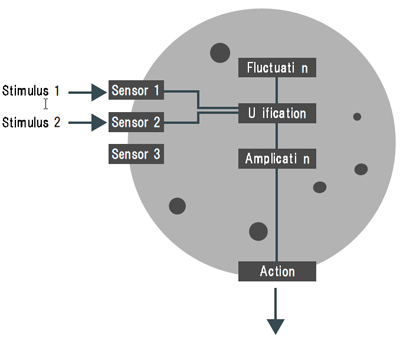
Figure 1: Schematic picture of the system
Negative electrotaxis has been known for Paramecium([1]). organisms orient themselves with respect
to the direction of the direction of current and moves toward negative electrode. Volvox carteri also have
electrotaxis. In the present study, as a single stimuli, we first examined the phototactic sign of Volvox as
a function of light intensity. Secondly, electric-field was applied, and the responce of the swimming cells
was studied.
In order to answer the question, "Which types of stimuli deose the animal select to resonce?", photostimili
and electric-stimili are applied at the same time to solution of Volvox carteri perpendicularly, and
the responce of the swimming cells was discussed.
Bibliography
- [1] Jennings HS, Behavior of the Lower Organisms (Indiana University Press, Bloomington, 1906)
- [2] D. L. Kirk and J. F. Harper, Int. Rev. Cytol. 99 217 (1986)
- [3] H. Sakaguchi and K. Iwasa, Plant and Cell Physiol. 20, 909 (1979)
- [4] H. Sakaguchi, Plant and Cell Physiol. 20, 1643 (1979)
- [5] F. Braun and P. Hegemann, Biophysical Journal 76 1668 (1999)
- [6] E. Ebnet, M. Fischer, W. Deininger, and P. Hegemann, The Plant Cell 11 1473 (1999)
- [7] H. Kaneda and M. Furuya, Plant and Cell Physiol 23 1377 (1982)
- [8] P. Halldal, Nature 179 215 (1957)
- [9] P. Halldal, Physiol. Plant 12 742 (1959)
- [10] J. H. Hoops, J. Cell Sci. 104 105 (1993)
- [11] J. H. Hoops, 1997. . Protoplasma. 199 99 (1997)
報告リスト
複合刺激に対する多細胞生物の応答
~ボルボックスの走性のカップリング~ 2008.11.20
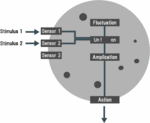
林叔克^{1,2}、鈴木由美子^2、菅原研^2 1 NPO 法人natural science 2 東北学院大学教養学部 概要 本研究ではボルボックスが有する走光性と走電性に注目し、複合刺激に対し多細胞生物がどのよ うに応答するかを調べた... [詳細]
多細胞生物における複合刺激に対する応答~ボルボックスの 走行性と送電性~ 2008.09.29
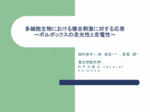
2008年 7月13日(日)、東北大学片平キャンパスさくらホールで行われたサイエンスカフェで、 「多細胞生物における複合刺激に対する応答~ボルボックスの走光性と走電性~」 というテーマで発表しました。 はじめに 自然の環境の中にはさまざま... [詳細]
多細胞生物における複合刺激に対する応答 ~ボルボックスの走光性と走電性~ 2008.04.01
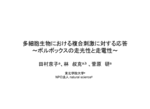
2008年 2月15日(金)、情報処理学会東北支部研究会で、 「多細胞生物における複合刺激に対する応答~ボルボックスの走光性と走電性~」 というテーマで発表しました。 はじめに 自然の環境の中にはさまざまな刺激があります。 生物は、環境中... [詳細]
ボルボックスの走性のカップリング 2007.10.11
この研究報告は2007年9月末の物理学会秋季大会での発表をまとめたものです。本研究は文部科学省の科学研究費により、東北学院大学で行われています。共同研究者は学院大の鈴木由美子さん、菅原研さんです。 ... [詳細]
日誌リスト

【目的整理】ボルボックスー判断のモデル生物 2008.06.14 【田村 京子|日誌|複合刺激に対するボルボックスの応答】

【第3回実験報告】ボルボックスー判断のモデル生物 2008.01.22 【田村 京子|日誌|複合刺激に対するボルボックスの応答】

【第2回実験報告】ボルボックスー判断のモデル生物 2008.01.04 【田村 京子|日誌|複合刺激に対するボルボックスの応答】

【第1回実験報告】ボルボックスー判断のモデル生物 2007.12.14 【田村 京子|日誌|複合刺激に対するボルボックスの応答】
n.s.研究所
About n.s.研究所
Activity 活動予定
- ■ 発表予定リスト
- ■ 大学生対象プロジェクト「国際学会へ行こう!」
- ■ 社会人対象共同研究プロジェクト「週末研究」
- ■ 高校生対象「コンピュータ・サイエンス」
- ■ ロボット開発プロジェクト「JOINロボコン」
Thema 研究テーマ
単細胞生物の行動に関する研究
多細胞生物の行動に関する研究
社会性昆虫の行動に関する研究
人の認識に関する研究
環境に関する研究
Thema 開発テーマ
ロボットの開発
- ■ LabVIEWによる制御
- ■ AVRマイコンの開発
- ■ センサーの開発
- ■ JOIN ロボコン
作ってみた
- ■ ソナーの開発
- ■ 万華鏡の開発
- ■ スターリングエンジンの開発
Lecture 講義
コンピュータ・サイエンス講座
- ■ コンピュータ・サイエンス講座とは?
- ■ 講座カリキュラム
- ■ 基礎講座
- ■ 応用講座
マイコン・サイエンス講座
- ■ 講座内容
Library ライブラリ
LabVIEWを使った物理数学集
VisualC++
Report 報告
学会等での発表
- ■ AROB 14th '09 (2009.02)
- ■ 計測自動制御学会東北支部(2008.12)
- ■ 日本物理学会(2008.09)
- ■ n.s.シンポジウム(2008.07.13)
- ■ 日本物理学会(2008.03)
- ■ 情報処理学会東北支部研究会(2007.12)
- ■ 日本物理学会(2007.09)
- ■ 日本物理学会(2007.03)
論文発表
その他の報告
NEWS
 2011.12.17
2011.12.17
小学校高学年対象:週末科学実験工作教室「音ってそもそも何だろう??~電子ピアノをつくろう~」- 2011.11.08
第23回 知能ロボットコンテストにおいて 科学講座受講生チームが「メカトロで遊ぶ会賞」を受賞しました - 2011.10.24
【小中学生対象】natural science 科学講座ウェブページ完成 - 2011.07.10
学都「仙台・宮城」サイエンス・デイ2011 無事終了!
Activities 更新情報
Warning: include(): http:// wrapper is disabled in the server configuration by allow_url_include=0 in /home/xsvx1015071/natural-science.or.jp/public_html/laboratory/research/multicellular/volbox.php on line 1054
Warning: include(http://www.natural-science.or.jp/log/latest.php): failed to open stream: no suitable wrapper could be found in /home/xsvx1015071/natural-science.or.jp/public_html/laboratory/research/multicellular/volbox.php on line 1054
Warning: include(): Failed opening 'http://www.natural-science.or.jp/log/latest.php' for inclusion (include_path='.:/opt/php-7.0.33-3/data/pear') in /home/xsvx1015071/natural-science.or.jp/public_html/laboratory/research/multicellular/volbox.php on line 1054
Ranking アクセスランキング
- 【メモ】プルダウンメニューにおける選択した選択肢の取得(JavaScript, addEventListener, changeイベント)
- 万華鏡について
- gnuplot 3次元カラーマップで補間(interpolate)
- 団体概要/About natural science
- gnuplot カラーマップの例(pm3d)
- コンセプト/About natural science
- AVRのタイマ割り込みを使う
- パブリシティ
- ■「natural science 科学・技術講座」夏休み短期講座のご案内
- 「国際イノベーションコンテスト2022世界大会」でnatural science『科学・技術講座』チームが世界3等入賞
Tag 記事タグ一覧
Warning: include(): http:// wrapper is disabled in the server configuration by allow_url_include=0 in /home/xsvx1015071/natural-science.or.jp/public_html/laboratory/research/multicellular/volbox.php on line 1072
Warning: include(http://www.natural-science.or.jp/log/tag.data): failed to open stream: no suitable wrapper could be found in /home/xsvx1015071/natural-science.or.jp/public_html/laboratory/research/multicellular/volbox.php on line 1072
Warning: include(): Failed opening 'http://www.natural-science.or.jp/log/tag.data' for inclusion (include_path='.:/opt/php-7.0.33-3/data/pear') in /home/xsvx1015071/natural-science.or.jp/public_html/laboratory/research/multicellular/volbox.php on line 1072

